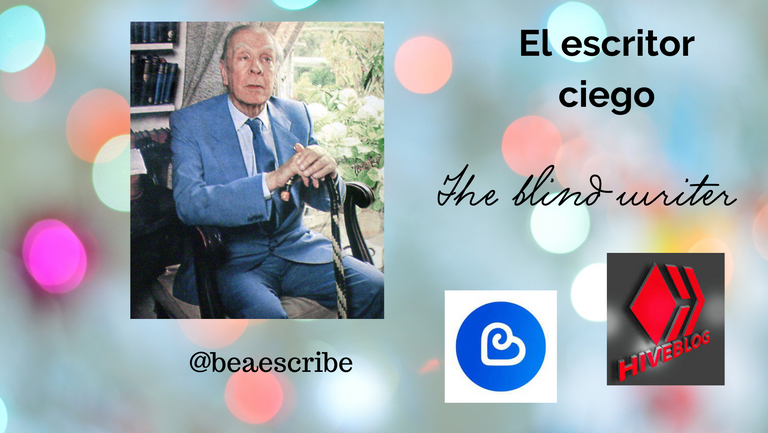
Cuando era niña me gustaba jugar a la ciega, cerraba los ojos y empezaba a caminar por la sala de mi casa para sentir cómo era la experiencia de no ver, cómo se sentía el mundo. Por alguna extraña razón, cuando vi el tema propuesto por los amigos de Ecency, para el nuevo reto de escritura pensé en uno de mis escritores favoritos, el escritor argentino Jorge Luis Borges, quien ya desde niño, por un problema genético tuvo dificultad para ver, como me ocurría en aquel juego infantil me imaginé a Borges viendo reflejos borrosos de colores. Entonces empecé a escribir el relato que les comparto en su homenaje. Espero que lo disfruten.

De niño el pequeño Jorge miraba los reflejos de la luz en el agua ensimismado. Pero lo que más le gustaba era leer cuentos, imaginar laberintos, lugares que sólo se encuentran en la imaginación. Podía estar horas en la biblioteca de su padre, ya ciego, saciando su curiosidad por civilizaciones antiguas, por mundos desaparecidos que revivía mientras leía, bosques poblados por criaturas mágicas, caballeros en busca de aventuras, damas en peligro en oscuros castillos. Esos mundos que lo alimentaron aún después que perdió la vista como su padre.
Los colores que conformaban su mundo eran tenues, el poeta los guardaba en las acuarelas de su memoria cuando escribió sus primeros versos dedicados a su ciudad, Buenos Aires, ciudad cosmopolita que recibió a Rubén Darío y a los emigrantes y exiliados italianos y españoles, que llegaron con su música y sus costumbres, recordando su patria perdida. A ritmo de tango llegó el amor y el desamor, los cuchilleros de sus primeros relatos, que se jugaban la vida en la oscuridad de barrios pobres de Buenos Aires, como aquel hombre de la esquina rosada.
Pero la vista no lo abandonó del todo hasta que había entrado a la madurez. Fue entonces, que definitivamente dejó de ver los reflejos y colores del mundo que lo rodeaba. Su madre, Leonor, su compañera más fiel, empezó a leerle los libros que ya no podía ver, o a transcribir los relatos que su imaginación prodigiosa creaba. Cuando ella murió, ya hacía tiempo que María, una joven estudiante de origen japonés, estaba en la vida del maestro y empezó a leerle y a transcribir los textos que él creaba y a describirle, hasta el día de su muerte en Ginebra, qué había en el mundo que compartían, especialmente cuando viajan. Porque el niño curioso que había en él no lo abandonó nunca.
 English version
English version
BETWEEN REFLECTIONS AND COLORS/THE BLIND WRITER (TRIBUTE TO JORGE LUIS BORGES)
When I was a child I liked to play blind, I would close my eyes and start walking around the living room of my house to feel what the experience of not seeing was like, how the world felt. For some strange reason, when I saw the theme proposed by Ecency's friends for the new writing challenge I thought of one of my favorite writers, the Argentine writer Jorge Luis Borges, who since he was a child, due to a genetic problem, had difficulty seeing, as it happened to me in that childhood game I imagined Borges seeing blurred reflections of colors. Then I began to write the story that I share with you in his homage. I hope you will enjoy.

When he was a child, little Jorge looked at the reflections of the light on the water in a dreamy way. But what he liked most was to read stories, to imagine labyrinths, places that can only be found in the imagination. He could spend hours in his father's library, already blind, satiating his curiosity for ancient civilizations, for vanished worlds that he relived while reading, forests populated by magical creatures, knights in search of adventure, ladies in danger in dark castles. Those worlds that nourished him even after he lost his sight like his father.
The colors that made up his world were faint, the poet kept them in the watercolors of his memory when he wrote his first verses dedicated to his city, Buenos Aires, a cosmopolitan city that received Rubén Dario and the Italian and Spanish emigrants and exiles, who arrived with their music and customs, remembering their lost homeland. To the rhythm of tango came love and heartbreak, the cutlers of his first stories, who risked their lives in the darkness of the poor neighborhoods of Buenos Aires, like that man on the pink corner.
But his eyesight did not completely abandon him until he had entered maturity. It was then that he definitively stopped seeing the reflections and colors of the world around him. His mother, Leonor, his most faithful companion, began to read to him the books he could no longer see, or to transcribe the stories his prodigious imagination created. When she died, Maria, a young student of Japanese origin, had already been in his life for some time and began to read to him and transcribe the texts he created and to describe to him, until the day of his death in Geneva, what was in the world they shared, especially when they traveled. Because the curious child in him never left him.
El texto es un contenido original que escribí, los banners y los separadores los diseñé en
http://www.canva.com
The text is an original content I wrote, the banners and the separators I designed on
http://www.canva.com
Translated with www.DeepL.com/Translator (free version)
Fuentes consultadas en internet sobre la vida del escritor argentino Jorge Luis Borges:
Sources consulted on the Internet about the life of the Argentine writer Jorge Luis Borges:
https://es.wikipedia.org/wiki/Jorge_Luis_Borges
https://www.cervantes.es/bibliotecas_documentacion_espanol/biografias/nueva_york_jorge_luis_borges.htm
https://www.sciencedirect.com/science/article/pii/S0187451916300452
La foto utilizada en el banner es de dominio público
Jorge Luis Borges en 1976









